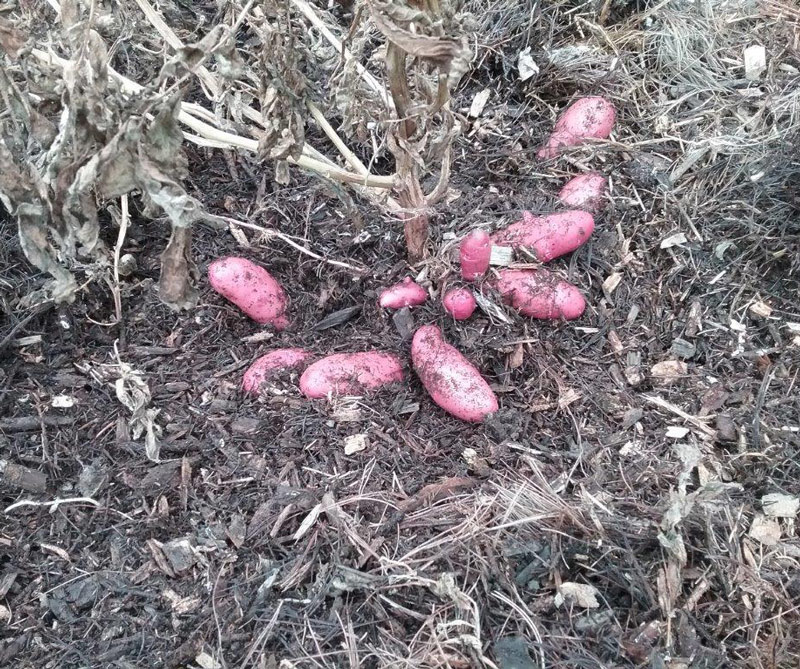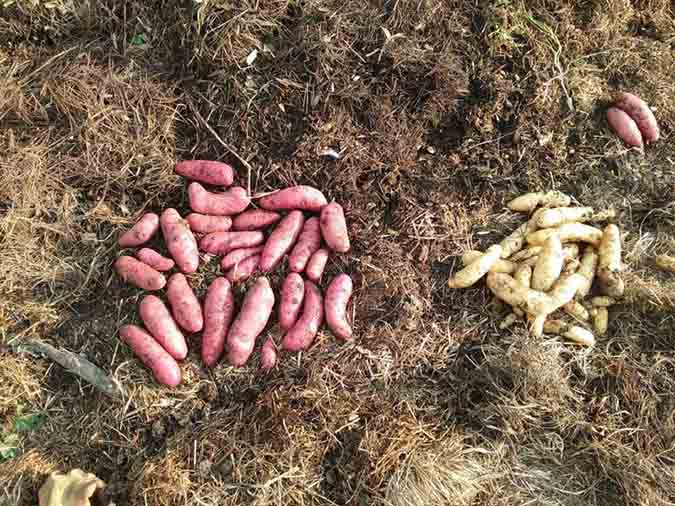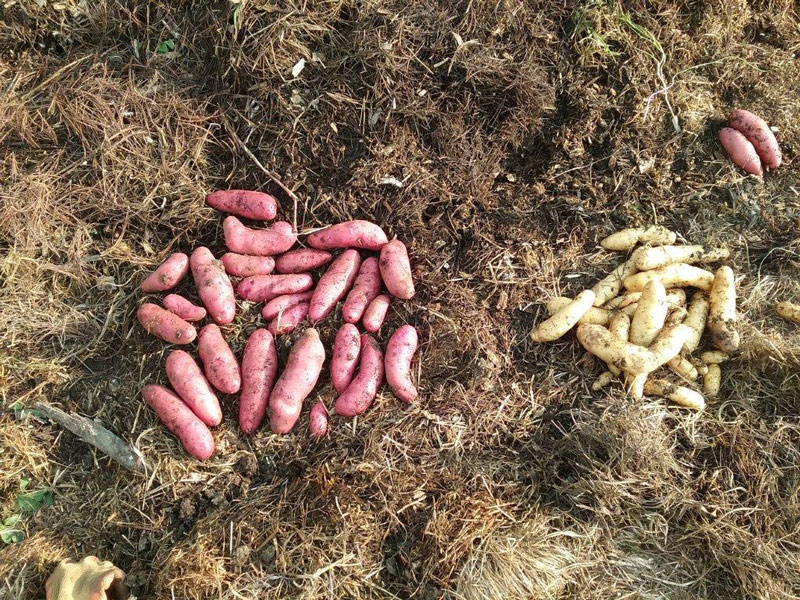Diane on Steve Solomon’s Soil and Health Group shared her method of planting potatoes in fall and graciously allowed me to share her comments and photos:
Read More: “Straw vs. Hay: Which Makes a Better Mulch?”

“This spring might be dicey, because we haven’t had consistent snow cover, but I always have spares for spring planting if needed. A bonus of the mulch is that, in 6 years, I’ve only had 3 Colorado beetles find my crop. As long as I notice them before they lay eggs, I’m beetle free.
“I’m very happy with my red variety in the photo: Amarosa—it’s a fingerling that grows clean and big and tasty.
“My second favorite is a Blue Russian and, last, a yellow fingerling that seems to grow much better with this system. I was going to drop the yellow fingerling because the spuds were too small, but now they are attaining a very good size. The photos show the harvest from individual plants > great production for fingerlings.
“I started a new zone last year by putting down cardboard on top of the grass/weeds, putting the potatoes on the cardboard, and burying them with wood chips. That worked, too. I’m a lazy gardener—no more digging for me! Plus, I can’t dig anywhere in my garden without chopping up zillions of worms—I hate doing that.”
Potatoes are hardier than I thought.
I had very good luck using deep-mulch gardening in rocky Tennessee clay, thanks to the piles of free mulch I got from the city. In Florida, where the mulch breaks down faster, I found it to be too much work—plus my gardens were a lot bigger.
The power of mulch as an insulator of roots is quite impressive. I had sweet potatoes—a true tropical—grow back from my mulch garden in spring in Tennessee after winter weather that reached down into the teens. The worm populations and the humus were also impressive, though the second year I gardened in deep mulch saw a plague of slugs which reached epic proportions.
Fortunately, Rachel and I were able to knock that out organically and keep growing.
The only downside I see to this system is the danger of getting poisoned hay. I recommend you grow your own if you can, or buy from an organic farm.
Read More: “The Hidden Dangers of Straw Bale Gardening”
Test, test, test. Planting potatoes in fall is radical, especially in zone 5, but it’s working for Diane. It may not work for you—but it also might do brilliantly. Try and see.
David The Good is a Grow Network Change Maker, a gardening expert, and the author of five books you can find on Amazon: Compost Everything: The Good Guide to Extreme Composting, Grow or Die: The Good Guide to Survival Gardening, Totally Crazy Easy Florida Gardening, Create Your Own Florida Food Forest, and Push the Zone: The Good Guide to Growing Tropical Plants Beyond the Tropics. Find fresh gardening inspiration at his website TheSurvivalGardener.com and be sure to follow his popular YouTube channel.










COMMENTS(5)
Inspiring article. It never ceases to amaze me what ingenuity can accomplish.
I have been wondering about this! My volunteer crop this year was much happier than my new potato bed. I was trying to figure out when I should test plant (in Grand Rapids Michigan) to get similar planned success, I so appreciate this analysis, thank you!
Love your books, David! I garden up here in the Inland Northwest – land of a million micro climates. My particular zone is 4 minus. This year I noticed my best potatoes were freebies planted last year that managed to miss being dug up. For next year’s crop I’m going to plant all my potatoes before the snow flies and mulch generously with non-sprayed oat straw.
I’ve done the sweet potato slips and seed potatoes for years, but started fall planting around 15 years ago. Here in Fayetteville NC, the sweet potatoes and regular potatoes start emerging pretty early so I cover them with straw or mulch is a late freeze is expected. I grow 3 varieties of potatoes and 6 varieties of sweet potatoes and I never rotate.
This is good to know. I am in zone 4a, and just about every spring I am surprised by some “volunteer” I didn’t expect, including occasional potatoes. They usually seem to do better than the things I plant. I think I will plant some potatoes this fall, as well as a few seeds of some hardier varieties of vegetables, just to see what happens. A thick mulch may be the answer to keep out the extreme cold, before sufficient snow falls to insulate them.